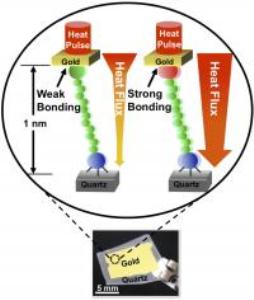Researchers at the University of Illinois have demonstrated that a single atom layer can either improve or disturb the flow of heat across an interface between materials. The study results have appeared in Nature Materials.
 "Through atomic-scale manipulation, researchers at the University of Illinois have demonstrated that a single layer of atoms can disrupt or enhance heat flow across an interface."
"Through atomic-scale manipulation, researchers at the University of Illinois have demonstrated that a single layer of atoms can disrupt or enhance heat flow across an interface."
Controlling heat exchange is an important factor in improving the performance of combustion engines and integrated circuits and also in emerging technologies like thermoelectric devices. On the other hand, achieving such control is impeded by an inadequate knowledge of heat conductivity across materials.
David Cahill, co-author of the paper and also the Head of materials science and engineering at the University of Illinois, informed that through phonons, heat passes across electrically insulating material. In contrast to in-depth understanding of how light and electricity travel through materials, researchers’ understanding of heat flow is still inadequate.
This aspect is attributed to the difficulty in determining temperatures precisely, particularly at over short period of time and at small-length scales. These are the limitations in which majority of nano and micro devices function.
Cahill's team has developed a measurement method in which short laser pulses are used to explore the flow of heat with nanometer-depth resolution. Cahill along with Paul Braun, a professor of Materials Science and Engineering at the University of Illinois, applied the method to gain insights on how atomic-scale manipulation impacts the transport of heat.
Under the experiments, the researchers first deposited a layer of molecules on a quartz surface to assemble a molecular sandwich. Then through a transfer-printing technique, a thin gold film was placed over these molecules. A heat pulse was then applied to the gold layer, and the heat pulse that traveled across the sandwich to the quartz was determined.
By altering the molecules’ composition, the researchers noted a change in heat transfer and this change depends on how strong the molecule adheres to the gold layer. The researchers showed that stronger bonding tends to increase the heat flow significantly.
The researchers have demonstrated that altering a single atom layer at the interface amid two materials can considerably affect the flow of heat across the interface.
Cahill added that these theories need to be developed further. The latest techniques will aid in calculating the degree at which interfacial structural elements contribute to heat flow.